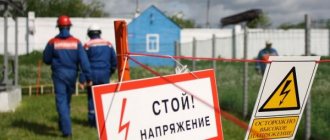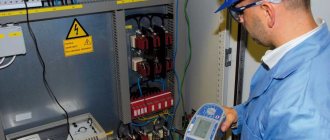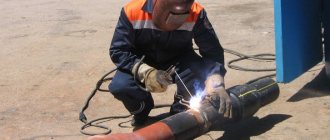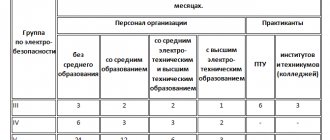Do you need electrical safety certification for tolerance group 5 up to and above 1000V? We will help. If you have a valid electrical safety certificate or when changing jobs, it often becomes necessary to confirm the previous group with Rostechnadzor. Contact us and we will promptly take care of all the necessary paperwork.
| Group | Voltage | Cost, rub) |
| Group II | Up to 1000V | 7000 |
| III group | Up to 1000V | 7000 |
| IV group | Up to 1000V | 7000 |
| IV group + admission to special work | Up to 1000V | 8000 |
| IV group | Up to 1000V and above | 12 000 |
| IV group + admission to special work | Up to 1000V and above | 13 000 |
| Group V | Up to 1000V and above | 12 000 |
| Group V + admission to special work | Up to 1000V and above | 13 000 |
Electrical safety certification is a mandatory procedure for personnel who perform electrical work, namely: installation, commissioning, startup, repair, maintenance and management of electrical installations. You can proceed to them only if you have a permit, which a special commission issues based on the results of certification.
What does certification for group 5 mean?
Confirmation that the employee has successfully passed the certification for the access group is a standard certificate, which contains a mark from the Rostechnadzor inspector. Electricity consuming companies from various fields of activity also receive a logbook for testing the knowledge of employees; electricity supply companies receive a similar logbook plus a knowledge test protocol signed by commission members.
Engineering and technical employees who belong to the V tolerance group have the right to work with electrical equipment with voltages up to and above 1000 Volts. This is the highest group, which allows the employee to manage electrical equipment and make strategic decisions regarding electrical equipment.
Electrical safety clearance group 5 is assigned to personnel with work experience of at least two years (in the absence of secondary education) and one year (with secondary education), as well as employees with secondary and higher electrical education with work experience of at least six months in the previous one (in our case, IV ) group.
Obtaining permission allows you to minimize, or even completely eliminate, risks and accidents that arise due to incorrect actions of workers who have access to electrical installations and power systems.
Operation of electrical installations using cranes
- EB 1349.2. Testing the knowledge of electrical and electrical engineering personnel of organizations operating consumer electrical installations using cranes (III group on electrical safety up to 1000 V)
- EB 1350.2. Testing the knowledge of electrical and electrical engineering personnel of organizations operating consumer electrical installations using cranes (III group on electrical safety above 1000 V)
- EB 1351.2. Testing the knowledge of electrical and electrical engineering personnel of organizations operating electrical installations of consumers using load-lifting cranes (IV group on electrical safety up to 1000 V)
- EB 1352.2. Testing the knowledge of electrical and electrical engineering personnel of organizations operating consumer electrical installations using load-lifting cranes (IV group on electrical safety above 1000 V)
- EB 1353.2. Testing the knowledge of electrical and electrical engineering personnel of organizations operating consumer electrical installations using load-lifting cranes (Electrical safety group V)
Where and how to get group 5
The Advanced Training Center offers up-to-date programs for the professional training of specialists applying for the 5th electrical safety group - up to and above 1000 V. Our teachers are highly qualified and have extensive experience.
As a result of the training, your employees will be fluent in working with electrical installations, electrical networks and any electrical equipment, know the current basics of safety and health when handling them, and master the techniques of providing first aid in case of electric shock.
Operation of power grid cable line equipment
- EB 1344.2. Testing the knowledge of electrical technical personnel of organizations operating cable line equipment for consumer power grids (III group on electrical safety up to 1000 V)
- EB 1345.2. Testing the knowledge of electrical technical personnel of organizations operating cable line equipment for consumer power grids (III group on electrical safety above 1000 V)
- EB 1346.2. Testing the knowledge of electrical technical personnel of organizations operating cable line equipment for consumer power grids (IV group on electrical safety up to 1000 V)
- EB 1347.2 Training and testing of knowledge of electrical technical personnel of organizations operating cable line equipment for consumer power grids (IV group on electrical safety above 1000 V)
- EB 1348.2. Testing the knowledge of electrical technical personnel of organizations operating cable line equipment for consumer power grids (Electrical Safety Group V)
Let us help you get Group V
Electrical safety certification for the electrical safety clearance group is an important condition for the legality of the enterprise’s activities and ensuring the safety of personnel associated with the maintenance of electrical installations. We will help you obtain standard certificates that confirm successful completion of certification:
- we will agree on the contract and fill out the application;
- we will submit the application to Rostechnadzor;
- prepare employees for certification;
- We will help you comply with regulatory procedures.
The final stage of cooperation will be the issuance of electrical safety certificates to your employees and a knowledge test log at the enterprise.
To begin training, you should prepare a referral from the company and indicate in it the employee’s position, length of service and the required level of clearance.
It is mandatory to take an exam for any electrical safety group in the following situations:
- the previous certification has expired;
- the employee moved to another position within the company or to another organization.
Be careful: electrical safety certification in Rostechnadzor for group 5 is carried out after the expiration of the previous certificate - after 1 year and after 3 years for inspectors.
Terms of cooperation
- We provide free consulting support - from filling out an application to obtaining admission.
- We offer a convenient distance learning form with the possibility of a teacher visiting the site (training in Moscow from any city in Russia with minimal disruption from production).
- We organize training for employees in accordance with current legislative requirements of the Ministry of Energy and the Ministry of Labor.
- We accept applications from organizations (we do not cooperate with individuals).
- We issue a copy of the training center protocol based on the results of training (upon individual request).
Working with us is beneficial: we guarantee certification by the federal supervisory authority - Rostechnadzor. As a result of cooperation, your employees receive standard certificates valid on the territory of the Russian Federation.
If you need certification for group 5 electrical safety in Rostechnadzor with the possibility of subsequent work with electrical installations up to and above 1000 V, we will help you obtain a certificate and provide the necessary products for training - electrical safety magazines and certificate forms (they can be purchased in our online store at an affordable price).
On this page you can see the cost of our services. We offer favorable conditions, including discounts for training large groups of employees of one enterprise. You can obtain detailed information about the terms, conditions for forming classes, and forms of training in a convenient way: by phone or through an online form. Leave your contacts on this page, and specialists will answer your questions free of charge and promptly.
G.1.EB 141.4 Testing for certification in Rostechnadzor for tolerance group V
Topic 1. General information about electrical installations.
Topic 2. General provisions of current standards and regulations when working in electrical installations.
Topic 3. Requirements for personnel and their training.
Topic 4. Procedure and conditions for safe work in electrical installations.
Topic 5. Grounding and protective safety measures. Lightning protection.
Topic 6. Rules for the use and testing of protective equipment used in electrical installations.
Topic 7. Rules for releasing victims from electric current and providing them with first aid.
Regulatory and technical literature for preparation:
- Rules for electrical installations
- Rules for technical operation of consumer electrical installations.
- Interindustry rules on labor protection (safety rules) during the operation of electrical installations.
- Instructions for the use and testing of protective equipment used in electrical installations.
- Instructions for the installation of lightning protection of buildings, structures and industrial communications (SO 153-34.21.122-2003).
- Intersectoral instructions for first aid in case of accidents at work.
- A textbook on the basics of electrical equipment and power supply for industrial enterprises.
Questions to test the knowledge of electrical engineering and electrical engineering personnel on electrical safety (access group V)
From the Rostechnadzor website.
1. How long does it take to carry out comprehensive testing of the main and auxiliary equipment of an electrical installation before putting it into operation?
2. How long does it take to conduct a comprehensive testing of the operation of a power transmission line before putting it into operation?
3. Who should ensure the reliability and safety of electrical installations?
4. For how long can duplication be extended for an employee if during the allotted time he has not acquired sufficient production skills?
5. How often should the electrical circuits of electrical installations be checked for compliance with actual operational ones?
6. How often should emergency lighting be inspected and checked for serviceability?
7. What acceptable accuracy class should active electricity meters for non-industrial facilities have?
8. How is electricity metered during the repair of electricity metering devices?
9. How is electricity metered during the repair of measuring instruments while the process equipment is running?
10. What material should artificial ground electrodes be made of?
11. What personal protective equipment should be used against step voltage in electrical installations above 1000 V?
12. What background should the warning sign “Caution! Electric voltage”, which is applied by means of a stencil to the reinforced concrete support of the overhead line.?
13. What background should the warning sign “Caution! Electrical voltage”, which is mounted on the outer door of the transformers?
14. What rooms are called dry?
15. What rooms are called damp?
16. Which rooms are considered wet?
17. Who carries out state supervision over compliance with the requirements of electrical safety rules and regulations in electrical installations?
18. Who belongs to the electrical engineering personnel?
19. Which of the listed works can be classified as work performed as part of routine operation in electrical installations with voltages up to 1000 V?
20. What document should electrical personnel have to carry out measurements with a megohmmeter in electrical installations with voltages up to 1000 V?
21. What administrative penalties are legal entities exposed to for unproductive consumption of energy resources?
22. Which objects are classified as ordinary objects in terms of the degree of danger of lightning damage?
23. What protective equipment is considered individual?
24. What protective equipment refers to additional insulating electrical protective equipment for electrical installations with voltages above 1000 V?
25. What protective equipment refers to additional insulating electrical protective equipment for electrical installations with voltages up to 1000 V?
26. What protective equipment are the main insulating electrical protective equipment for electrical installations with voltages above 1000 V?
27. What protective equipment are the main insulating electrical protective equipment for electrical installations with voltages up to 1000 V?
28. In what electrical installations are dielectric gloves used as the main insulating electrical protective equipment?
29. In what electrical installations are dielectric gloves used as an additional insulating electrical protective equipment?
30. In which electrical installations do you need to wear dielectric gloves when using a voltage indicator?
31. In what electrical installations are dielectric boots used?
32. In what electrical installations are dielectric galoshes used?
33. Which posters are warning signs?
34. Which posters are prohibitive?
35. What posters are classified as indicative?
36. How are electrical installations divided according to electrical safety conditions?
37. Who is covered by the Inter-industry rules on labor protection (safety rules) when operating electrical installations?
38. Which personnel are classified as non-electrical?
39. Which personnel are classified as administrative and technical?
40. In what sequence is it necessary to carry out technical measures to ensure the safety of work with stress relief?
41. What voltage should be used to power portable (hand-held) lamps used in hazardous areas?
42. What inscription should be written on the electric energy meter?
43. When is lightning protection devices checked and inspected?
44. In what electrical installations can pilot lamps be used as voltage indicators?
45. What are clamp meters used for?
46. What are the managers and specialists of the energy service personally responsible for?
47. Which electrical receivers, in terms of ensuring the reliability of electrical receivers, belong to the first category of electrical receivers?
48. Which power receivers in terms of ensuring the reliability of power supply belong to the power receivers of the second category?
49. Which electrical safety group should the person responsible for electrical equipment in electrical installations with voltages up to 1000 V have?
50. Which electrical safety group should the person responsible for electrical equipment in electrical installations with voltages above 1000 V have?
51. Which electrical safety group should the work manufacturer have when testing electrical equipment?
52. In which electrical installations can work be performed in the order of routine operation?
53. What prohibiting posters are hung on the drives of switching devices to prevent voltage from being applied to the workplace during repairs or routine inspection of equipment?
54. In what cases is it permissible to use non-standardized measuring instruments?
55. What is meant by touch voltage?
56. What is meant by step voltage?
57. What should an employee do if he notices a malfunction in the electrical installation or protective equipment?
58. Which rooms are classified as electrical rooms?
59. Within what period of time from the date of the last knowledge test can employees who received an unsatisfactory assessment be re-tested?
60. Who conducts targeted training for team members during work assignments?
61. For how long can a work order for work on electrical installations be extended?
62. Who has the right to connect and disconnect electric welding installations from the network?
63. What should be the verification period for a current transformer built into power equipment?
64. When should protection against indirect contact be performed?
65. What type of safety poster is a poster with the inscription “Grounded”?
66. What type of safety poster is a poster with the inscription “Don’t get in! Will he kill?
67. How many voltage indicators should a team servicing cable lines have with them to check phase coincidence?
68. Which electrical installations are subject to the requirements of the Electrical Installation Rules?
69. What letter and color designations should tires have for three-phase alternating current?
70. What letter and color designations should buses have for direct current?
71. How many people should be on the organization’s commission for testing the knowledge of electrical personnel?
72. What temperature should the transferred cable be under voltage?
73. What is the storage period for work logs on work orders and orders?
74. Who has the right to open electrical measuring instruments not related to work on the normal functioning of recording devices?
75. In circuits, at what voltage should the current be measured?
76. What color should openly laid grounding conductors be painted?
77. How many insulating clamps for voltages up to 1000 V should be at the workplace of operational and repair personnel?
78. How are premises classified with respect to the danger of electric shock to people?
79. How long does duplication take place before electrical personnel are allowed to work independently?
80. Which electrical safety group should employees from among the operational personnel who solely service electrical installations have?
81. What is indicated in the “Division” line when filling out a work permit for work in electrical installations?
82. When is it necessary to verify the calculated means of accounting for electrical energy?
83. Which of the following grounding systems belongs to the TN-C-S system?
84. Which of the following grounding systems belongs to the TT system?
85. Which of the following grounding systems belongs to the TN-C system?
86. Which of the following grounding systems belongs to the TN system?
87. Which of the following grounding systems belongs to the TN-S system?
88. Which of the following grounding systems belongs to the IT system?
89. Who is covered by the Rules for the Technical Operation of Consumer Electrical Installations?
90. What are the requirements for posted personnel?
91. How many people should be in the team performing work on re-stretching and replacing wires on overhead power lines with voltages up to 1000 V?
92. What must be indicated in the work permit next to the surname and initials of the workers?
93. Which megger is used to measure insulation resistance when testing circuits with voltages up to 500 V?
94. Which megger is used to measure insulation resistance when testing circuits with voltages from 500 to 1000 V?
95. How should transverse grounding conductors of grounding devices of electrical installations with voltages above 1 kV be laid in networks with an effectively grounded neutral?
96. What structural elements of buildings and structures can be considered as natural lightning rods?
97. Who determines the category of power receivers based on the reliability of power supply?
98. Which premises are classified as high-risk premises?
99. What frequency of advanced training should an employer provide for staff?
100. Who can be responsible for the safe conduct of work?
101. What combination of duties is allowed for the responsible work manager?
102. Who should carry out routine verification of electric meters?
103. Who should replace the estimated electric meters?
104. Who should install and replace current and voltage instrument transformers?
105. In what circuits is voltage measured?
106. In which electrical installations are voltage indicators used to check phase coincidence?
107. In which electrical installations is a person responsible for electrical equipment appointed?
108. Which of the following are the responsibilities of the person responsible for electrical equipment?
109. How often is electrical safety knowledge tested for electrical personnel?
110. Who has the right to single-handedly service electrical installations with voltages up to 1000 V?
111. Which of the listed activities are organizational?
112. Who should be in charge of technical metering devices for electricity in an organization?
113. What conditions must an organization fulfill to conclude an Energy Supply Agreement with an energy supply organization?
114. Which objects are classified as special objects in terms of the degree of danger of lightning damage?
115. What letter and color designation should protective grounding conductors in electrical installations have?
116. What letter and color designation should the combined neutral protective and neutral working conductors have?
117. What neutral should 10 kV electrical networks operate with?
118. What measures are taken against an employee who, during the duplication period, was found to be unsuitable for this type of activity?
119. What minimum work experience should a person with a secondary electrical engineering education have to move from the fourth electrical safety group to the fifth?
120. How often should inspections of cable wells with voltage lines up to 35 kV be carried out?
121. What safety measures must be taken to prevent erroneous switching on of switching devices in the absence of fuses in the circuit during scheduled repairs of an electrical installation?
122. On what basis is energy supplied to organizations?
123. How are grounding conductors connected to the ground electrode and grounding structures?
124. What liability is provided for violation of rules and regulations during the operation of electrical installations?
125. What are employees who directly service electrical installations personally responsible for?
126. For what are workers carrying out repairs of electrical installations personally responsible?
127. What initial electrical safety group can be assigned to an employee when he is transferred from servicing electrical installations with voltages up to 1000 V to servicing electrical installations with voltages above 1000 V?
128. How long should work orders for which work is completely completed be stored?
129. How many workers, and with which electrical safety group, should check the absence of voltage on overhead lines with voltages above 1000 V?
130. What are safety helmets used for?
131. Who can receive targeted instruction when working on the job?
132. Who has the right to conduct a single inspection of electrical installations with voltages above 1000 V?
133. Who should have operational diagrams of electrical installations of a separate section?
134. In what case is a break in the power supply of an organization allowed without the consent of the subscriber?
135. Is it possible to use expired protective equipment?
136. What are the requirements for the appearance of dielectric carpets?
137. What administrative fine can legal entities be subject to for commissioning electrical installations without permission from the relevant authorities?
138. What administrative fine can officials of an organization be subject to for damage to overhead power lines with voltages above 1000 V?
139. What administrative fine can officials of an organization be subject to for damage to underground cable lines with voltages up to 1000 V?
140. How long should electrical technical personnel undergo on-the-job training before being assigned to independent work?
141. Who should be appointed as a permitter in electrical installations?
142. How are responsible employees appointed in the organization for maintaining portable and mobile electrical receivers in good condition?
143. What is the frequency of inspections of grounding devices with selective opening of the soil?
144. When are extraordinary measurements of the resistance of lightning protection devices carried out?
145. How can an employee, during direct use, determine that electrical protective equipment has passed performance tests and is suitable for use?
146. How is voltage supplied to electrical installations approved for operation in accordance with the established procedure?
147. Which electrical safety group should the chairman of the commission for testing the knowledge of electrical personnel of the Consumer with electrical installations above 1000 V have?
148. Which electrical safety group should a person allowed to work in electrical installations have?
149. In what case should electric motors be immediately disconnected from the mains?
150. Who in the organization monitors the operation of electricity meters?
151. What protective measures are used to protect people from electric shock due to indirect contact in the event of insulation damage?
152. What is the frequency of inspection of the condition of protective equipment used in electrical installations?
153. Which electrical installation is considered operational?
154. How are the results of testing personnel knowledge on electrical safety documented?
155. For what period is an order issued for work on electrical installations?
156. What protection zone is established for underground cable power lines with voltage up to 1000 V in cities under sidewalks?
157. How is the phase-zero circuit checked in electrical installations up to 1 kV with a TN system?
158. What can be used as natural grounding agents?
159. For how long should the voltage indicator be in direct contact with the controlled live parts when checking the absence of voltage in electrical installations with voltages up to 1000 V?
160. How many power sources are needed to organize power supply to power receivers of the second category?
161. How are zero working (neutral) conductors designated?
162. What training must electrical personnel undergo before starting work according to the order?
163. What kind of training should seconded personnel undergo upon arrival at the place of their assignment?
164. Who has the right to issue orders and orders in electrical installations with voltages above 1000 V?
165. Who should periodically conduct random inspections of cable lines?
166. What can be used as PE conductors in electrical installations with voltages up to 1000 V?
167. What regulatory and technical documents must the design of electrical installations meet?
168. What is the maximum fine imposed on officials of the Consumer by state inspectors of the energy supervision Rostechnadzor?
169. When is the next test of knowledge of administrative and technical personnel not involved in issuing orders and orders carried out?
170. What is confirmation of the conduct and receipt of targeted instruction by team members?
171. What prohibitory posters are hung on valves that block the access of air to the pneumatic drives of disconnectors, in order to prevent the supply of voltage to the workplace during repairs or routine inspection of equipment?
172. What is called working grounding?
173. How are power tools and hand-held electrical machines classified according to the method of protection against electric shock?
174. What testing of personnel knowledge is carried out when appointing or transferring to another job if new duties require additional knowledge of rules and regulations?
175. What work is classified as stress relief work?
176. According to what document are electrical equipment tests carried out using a mobile testing unit?
177. What is called protective grounding?
178. How are dielectric gloves checked for punctures?
179. What is the minimum number of dielectric gloves that should be in switchgear with voltages up to 1000 V?
180. How many voltage indicators up to 1000 V should a team servicing overhead power lines have?
181. What groups are the electrical technical personnel of the organization divided into?
182. When is a responsible work manager appointed?
183. What combination of duties is allowed for a work performer from among the operational and repair personnel?
184. What material should the main grounding bus be made of?
185. In what case should the grounding element be replaced?
186. What age restrictions exist for assignment to electrical safety group III?
187. For what period is a work order issued for work on electrical installations?
188. What work on the management of electrical installations with voltages above 1000 V can be carried out by one employee with a third electrical safety group?
189. How many overhead line supports with grounding devices are subject to selective soil opening to inspect these grounding devices?
190. Who instructs the team on the use of tools and devices?
191. What is the supervisor responsible for in electrical installations?
192. What should be the resistance of the grounding device to which the terminals of the transformer source are connected at a linear voltage of 380 V of a three-phase current source?
193. From what sources should mobile electrical installations be powered?
194. In what case should a certificate testing knowledge of norms and rules for working in electrical installations be replaced?
195. Who approves the List of positions and professions of electrical personnel who need to have an appropriate electrical safety group?
196. Where is the knowledge testing of Consumer employees whose numbers do not allow them to create their own commission?
197. To whom can the issuing outfit provide targeted instruction during work assignments?
198. What frequency of testing knowledge on electrical safety is established for personnel servicing electrical installations?
199. Which electrical safety group should the chairman of the commission for testing the knowledge of personnel of an organization with electrical installations up to 1000 V have?
200. How can team members who have a third electrical safety group temporarily leave the workplace in the switchgear?
201. Who belongs to the operational and repair personnel?
Operation of electrical installations using welding equipment
- EB 1354.2. Testing the knowledge of electrical and electrical engineering personnel of organizations operating consumer electrical installations using welding equipment (III group on electrical safety up to 1000 V)
- EB 1355.2. Testing the knowledge of electrical and electrical engineering personnel of organizations operating consumer electrical installations using welding equipment (III group on electrical safety above 1000 V)
- EB 1356.2. Testing the knowledge of electrical and electrical engineering personnel of organizations operating consumer electrical installations using welding equipment (IV group on electrical safety up to 1000 V)
- EB 1357.2. Testing the knowledge of electrical and electrical engineering personnel of organizations operating consumer electrical installations using welding equipment (IV group on electrical safety above 1000 V)
- EB 1358.2. Testing the knowledge of electrical and electrical engineering personnel of organizations operating consumer electrical installations using welding equipment (Electrical safety group V)
Operation of electrical installations using electric motors as the main equipment
- EB 1359.2. Testing the knowledge of electrical and electrical engineering personnel of organizations operating consumer electrical installations using electric motors as the main equipment (III group on electrical safety up to 100
- EB 1360.2. Testing the knowledge of electrical technical personnel of organizations operating consumer electrical installations using electric motors as the main equipment (III group on electrical safety above 1000 V)
- EB 1361.2. Testing the knowledge of electrical and electrical engineering personnel of organizations operating electrical installations of consumers using electric motors as the main equipment (IV group on electrical safety up to 1000
- EB 1362.2. Testing the knowledge of electrical and electrical engineering personnel operating consumer electrical installations using electric motors as the main equipment (IV group on electrical safety above 1000 V)
- EB 1363.2. Testing the knowledge of electrical and electrical engineering personnel of organizations operating electrical installations of consumers using electric motors as the main equipment (V electrical safety group)










